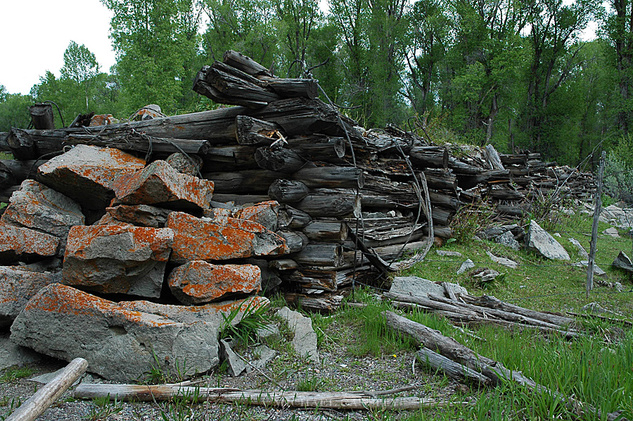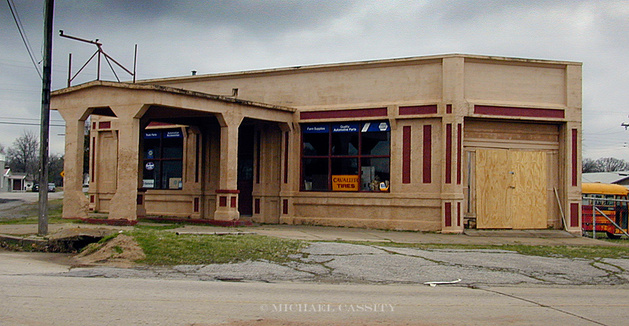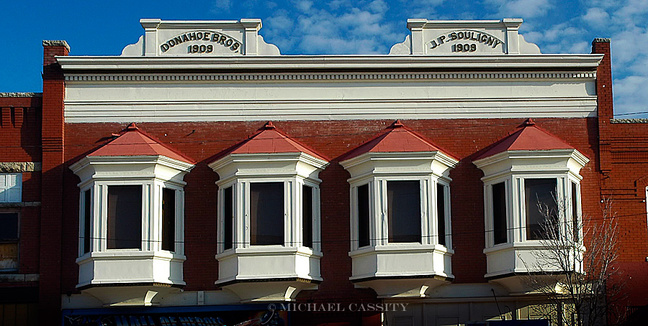On Local History as an
Important Area of Historical Inquiry

Sign on side of Dick and Runt's Barbecue, Ponca City, Oklahoma.
At the beginning of my career, I chose to focus my research on a particular community in hopes of understanding the larger forces at work shaping the nation. This was a conscious choice, and I have never regretted it, but it was one that caused friends and colleagues to raise their eyebrows. It was not so much the particular community that I had chosen, but that I had chosen a community, a city, a county, rather than national business or political institutions as my subject. It was all the more perplexing to some because few people outside its residents had ever heard of that county. Where was the importance? Where was the history? Wasn’t this just an exercise in documenting local pride and progress? My response was then, as it is now, that the history of our nation is understood best when looked at where the people live and work, where they make their homes, where they watch their businesses thrive (or watch them shrivel), where they find jobs (or don’t find jobs), where they attempt to fulfill their dreams, where they encounter frustrations and opportunities that go beyond their individual abilities. It is, of course, not so much the particular place we choose to examine, but what questions we ask, wherever we direct our attention, that determines the value of our historical research. It is possible to ask large, really fundamental, meaning-of-life kinds of questions of life in small towns just as it is possible to ask silly, dead-end questions of activity in the halls of power. What is important is which questions we choose to ask. And, it may well be that there are some important questions that can be asked, and answered, only at the local level where life is lived.
When I undertook my research on Sedalia and Pettis County, Missouri, more than a few people asked me why there? Why not some other place? Good questions, obviously. The expected response was that I chose Sedalia because I was from there. But I wasn’t. Instead, my response was that I was a historian, and I was interested in the social processes at work there in the transformation of the community from a nineteenth century frontier settlement (almost—it took the place of the actual frontier settlements nearby and rose to prominence while the others faded) to a twentieth century industrial city. It had undergone some dramatic processes of change from a pre-industrial and slave-holding community to the building up a town that synchronized itself to the rest of the commercial and industrial world of Gilded Age America.
I will also note that this is not an entirely personal, idiosyncratic view of history. Indeed, one of my essays on the value of this approach looked at small town developments that raised questions about the larger patterns of change abroad in the nation. In my research on Sedalia, Missouri, I had discovered that the organization—and response to—railroad strikes that originated in that community in the 1880s showed an underlying, pervasive skepticism or rejection of the forces of modernization in the nation—its centralization of power, its fragmentation of communities, its reduction of people to economic transactions—and this conceptual analysis was published in the prominent Journal of American History. That’s not such a big deal in itself, but it does suggest that there are larger questions that historians must ask before they accept the processes at work in the creation of a “modern” American social structure to be inevitable, to be wonderful, or to be acceptable.
Please note: I have not been able to include all resources surveyed of all the surveys I have conducted. As time permits, I will try to add to these pages, but it is a slow process and depends on time being available, which is not often.
When I undertook my research on Sedalia and Pettis County, Missouri, more than a few people asked me why there? Why not some other place? Good questions, obviously. The expected response was that I chose Sedalia because I was from there. But I wasn’t. Instead, my response was that I was a historian, and I was interested in the social processes at work there in the transformation of the community from a nineteenth century frontier settlement (almost—it took the place of the actual frontier settlements nearby and rose to prominence while the others faded) to a twentieth century industrial city. It had undergone some dramatic processes of change from a pre-industrial and slave-holding community to the building up a town that synchronized itself to the rest of the commercial and industrial world of Gilded Age America.
I will also note that this is not an entirely personal, idiosyncratic view of history. Indeed, one of my essays on the value of this approach looked at small town developments that raised questions about the larger patterns of change abroad in the nation. In my research on Sedalia, Missouri, I had discovered that the organization—and response to—railroad strikes that originated in that community in the 1880s showed an underlying, pervasive skepticism or rejection of the forces of modernization in the nation—its centralization of power, its fragmentation of communities, its reduction of people to economic transactions—and this conceptual analysis was published in the prominent Journal of American History. That’s not such a big deal in itself, but it does suggest that there are larger questions that historians must ask before they accept the processes at work in the creation of a “modern” American social structure to be inevitable, to be wonderful, or to be acceptable.
Please note: I have not been able to include all resources surveyed of all the surveys I have conducted. As time permits, I will try to add to these pages, but it is a slow process and depends on time being available, which is not often.
Historic Property Surveys Conducted

Wagon Wheel Motel, Jackson, Wyoming.
Downtown Ponca City, Oklahoma (2008)

Nonnamaker Building / Music Hall, Ponca City, Oklahoma.
This survey was one that took me back to my roots, back to the town where I grew up, where I went to school, where I had my first job, where I have returned many times.
Click on the following button to go to a discussion of that survey.
Teton County, Wyoming: Historic Site Survey, 2004

Snake River Jetty, Teton County.
This survey was the third survey I performed for the Teton County Historic Preservation Board. It was not confined to a specific part of the county, although the resources were largely outside Grand Teton National Park. Some were in the towns of the county and others were dispersed throughout the rest of the county.
You can access that 2004 survey and information about it at this link:
You can access that 2004 survey and information about it at this link:
Teton County, Wyoming: Historic Resource Survey, 1999

The 1999 Teton County survey focused on historic resources located within the town of Jackson, Wyoming. To see more information about that survey and the results of it, click on the following button:
Teton County, Wyoming: Historic Resource Survey, 1998

VandeWater Barns, Teton County.
The first survey conducted by the newly created Teton County Historic Preservation Board attempted to identify the varieties of historic resources around the county as a basis for future surveys, nominations, and focused attention. For results of this survey, click on the button below:
Oklahoma Route 66 Historic Resources Survey, 1926-1970 (2002)

1920s Service Station, Depew, Oklahoma.
In 2002, the Oklahoma State Historic Preservation Office, with the support of the Route 66 Program in the National Park Service Long Distance Trails Office, launched a survey to identify historic resources along historic Route 66 in Oklahoma. I prepared the Historic Context Statement and surveyed properties throughout the length of Highway 66 in the state, from the northeast corner where 66 entered the state near Baxter Springs, Kansas, to its departure on the southwest at Texola; Heath Henry surveyed properties in the Oklahoma City and Tulsa metropolitan areas. The survey identified more than 300 properties and inventoried in the Oklahoma Landmarks Inventory 182 of them. The following year I nominated twenty of these properties to the National Register of Historic Places. More nominations followed in subsequent years.

